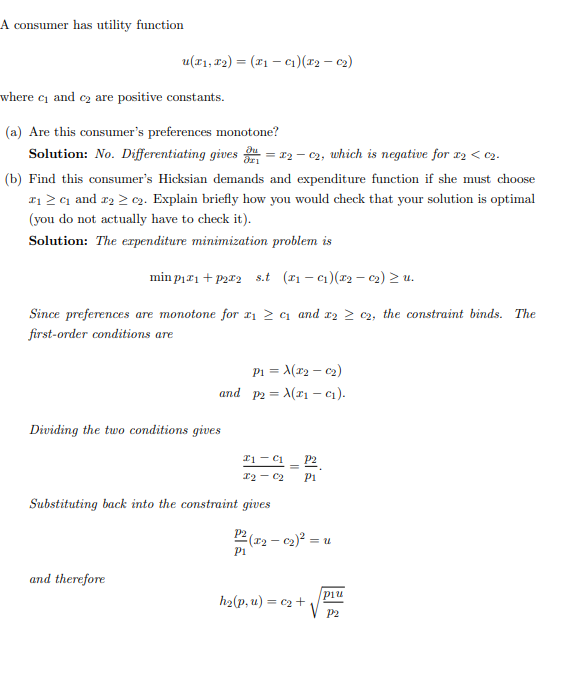A consumer has utility function u(T₁, 12) = (11 — C₁) (12 - 0₂) where c₁ and ₂ are positive constants. (a) Are this consumer's preferences monotone? Solution: No. Differentiating gives = 12 - C2, which is negative for 12 < €2. (b) Find this consumer's Hicksian demands and expenditure function if she must ch 1₁ ≥ 4₁ and 1₂ ≥ 0₂. Explain briefly how you would check that your solution is opti (you do not actually have to check it). Solution: The expenditure minimization problem is min p₁z₁+p2x2 st (₁-C₁) (12 - 0₂) ≥ u.
A consumer has utility function u(T₁, 12) = (11 — C₁) (12 - 0₂) where c₁ and ₂ are positive constants. (a) Are this consumer's preferences monotone? Solution: No. Differentiating gives = 12 - C2, which is negative for 12 < €2. (b) Find this consumer's Hicksian demands and expenditure function if she must ch 1₁ ≥ 4₁ and 1₂ ≥ 0₂. Explain briefly how you would check that your solution is opti (you do not actually have to check it). Solution: The expenditure minimization problem is min p₁z₁+p2x2 st (₁-C₁) (12 - 0₂) ≥ u.
Chapter4: Utility Maximization And Choice
Section: Chapter Questions
Problem 4.13P
Related questions
Question
please only do: if you can teach explain steps

Transcribed Image Text:A consumer has utility function
u(x₁, x2) = (x₁ - C₁) (x₂ - 0₂)
where c₁ and ₂ are positive constants.
(a) Are this consumer's preferences monotone?
Solution: No. Differentiating gives = x2-02, which is negative for x2 < c₂.
(b) Find this consumer's Hicksian demands and expenditure function if she must choose
1₁ ≥ ₁ and 2₂ ≥ 02. Explain briefly how you would check that your solution is optimal
(you do not actually have to check it).
Solution: The expenditure minimization problem is
min p₁æ1+p2æ2 s.t (₁-₁)(x₂ - 0₂) ≥ u.
Since preferences are monotone for x₁ ≥ c₁ and x₂ ≥ c2, the constraint binds. The
first-order conditions are
and therefore
P1 = √(x₂ - 0₂)
and p2= (₁-C₁).
Dividing the two conditions gives
21 C1
P2
X2 C2 P1
Substituting back into the constraint gives
P2 (x₂-0₂)² = u
P1
h₂(p, u) = c₂ +
più
P2
Expert Solution
This question has been solved!
Explore an expertly crafted, step-by-step solution for a thorough understanding of key concepts.
Step by step
Solved in 5 steps with 3 images

Knowledge Booster
Learn more about
Need a deep-dive on the concept behind this application? Look no further. Learn more about this topic, economics and related others by exploring similar questions and additional content below.Recommended textbooks for you

